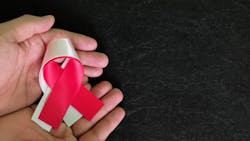Oral cancer screening: Resources for dental professionals
April is Oral Health Awareness Month—are you doing your part?
It’s not always easy to make the time to properly screen your patients for oral cancer during a hygiene appointment, but doing so is the standard of care and essential to your patients’ oral health.
And with the overall death rate from oral cancer having increased .4% per year from 2009 to 2020 after decades of decline,1 it’s more important than ever to take this life-saving step.
Learn from some of our best content on the role of dental hygienists with oral cancer and oral cancer screening—in April and the whole year through.
“It is nonnegotiable”
Tricia Markise Wonderly pulls no punches with her dental colleagues, noting that fewer than 15% to 25% of patients who visit a dentist regularly report having had an oral cancer screening at all. “When you do not take the time to examine key landmarks, the patient in your chair could die within five years of diagnosis once it finally is diagnosed in advanced stages,” she says. Wonderly provides easy-to-follow checklists for both intra- and extraoral screenings and says it is “nonnegotiable that all these areas must be carefully screened.”
The basics of a screening most hygienists never do (includes checklists)
How to screen correctly
Susan Cotten is an expert on oral and oropharyngeal cancer evaluation and creator of the “Cotten Method," a comprehensive office system specific to oral cancer, assisting dental providers in early detection while reducing risk for liability. Her comprehensive guide includes each step of a complete head and neck oral/oropharyngeal screening, as well as photos to help guide the process.
An excellent resource for Oral Cancer Awareness Month (includes downloadable resource)
Every patient, every time
“I’m sure we would all rather tell a patient, ‘I found something, but we caught it early and we can take care of it,’ and not, ‘I’m so sorry,’” writes Rebecca Rosser. To that end, she urges her fellow hygienists to be transparent, use the best technologies available—and screen every patient in who comes in.
Why you should screen every dental patient
The day when everything changed
Kathryn Gilliam never imagined taking shortcuts or skipping steps … until she did. Read how that unintentional yet fateful decision had very serious effects on her patient: “The lump in Kevin’s neck was there the last time I had seen him and had I bothered to perform the extraoral exam, as I always had before, I would have detected it and urged him to get a biopsy.”
The dental professional's role in head and neck cancer
Add policies to streamline screenings
One approach to ensuring you’re examining each patient, writes Shelley Brown, is to sit down with your team to discuss how your practice will manage oral cancer screenings. Discuss making policies who performs the screenings, when in the appointment they’ll be done, how frequently they’ll be done, and how the results will be recorded.
Your role in oral cancer screening: When, how, and why (includes how-to video)
5 questions you should be asking
Even when clinicians are thorough in their exams, is that enough? For some patients, it might not be: most HPV-related oropharyngeal cancers may not be visibly detectable because of their location, writes Alison Stahl, who lists some warning signs and symptoms questions to ask patients.
Are you asking the right questions to prevent oral cancer?
“I want to help you”
Following her own experiences with patients diagnosed with oral cancer, Dental Economics editor Dr. Pamela Maragliano-Muniz says that “As dental professionals, we have the opportunity to partner with our patients and medical colleagues to keep our patients as dentally healthy and comfortable as we possibly can.” She created a downloadable email with product recommendations, an explanation regarding tooth decay and xerostomia, the role of xerostomia in the caries process, and ways to help mitigate or prevent dental disease.
I want to help you with your oral cancer diagnosis (includes downloadable patient email)
Reference
1. American Cancer Society. Key Statistics for Oral Cavity and Oropharyngeal Cancers. Accessed April 4, 2023. https://www.cancer.org/cancer/oral-cavity-and-oropharyngeal-cancer/about/key-statistics.html
About the Author
Elizabeth S. Leaver
Elizabeth S. Leaver is the digital content manager for Endeavor Business Media's dental group. She has a degree in journalism from Northeastern University in Boston. Before diving into the dental world, she spent years working in niche industries specializing in creating content, editing, content marketing, and publishing digital and magazine content. She lives in the Boston area.
